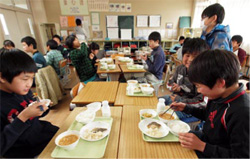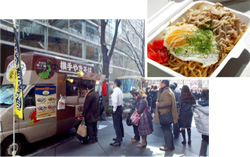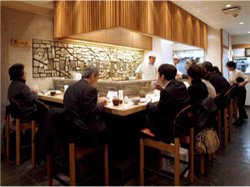Home > Highlighting JAPAN > Highlighting Japan APRIL 2012 > Out to Lunch
Highlighting JAPAN
COVER STORY: Food, Glorious Japanese Food
Out to Lunch
What do people eat in Japan? Visit a busy place during lunchtime and you'll find all different kinds of food being served. The Japan Journal's Osamu Sawaji reports.

Sixth graders tuck in to their school lunch.
Credit: TADASHI AIZAWA
School Lunches
"Always maintain good posture!"
"Thank you to all those who made this food!"
The twenty-one students who make up Class 1 in the second grade at Nishisugamo Elementary School (Toshima Ward, Tokyo) all put their hands together and say these words in unison, before happily tucking into their school lunches. Today's menu is rice, grilled fish, sesame seed-coated boiled potatoes, salad with ham and vegetables, egg and tomato soup, and a glass of milk.
Around 99% of elementary school students in Japan, and roughly 86% of junior high school students, currently have school lunches. Menus typically consist of a main dish, a vegetable side, soup and a staple accompaniment of either bread or rice, as well as a drink and a dessert.
A number of schools teach dietary education through their school lunches. Nishisugamo Elementary (total 220 students) is one such school. By doing so, they are increasing the students' knowledge about food, and making them into people who know how to eat healthily. Having the students peel the vegetables used for the lunches, think of combinations of staple foods and main dishes, then choose foods they want for their own school lunch are all part of the program. One fourth-grade girl says, "School lunch is fun because it's delicious and we can all eat together. When there's a really delicious food for lunch, and I want my mom to make it too, then I ask the nutritionist who prepares the food to tell me how to make it."

The line for the Yokote yakisoba truck. A serving of Yokote yakisoba costs just 500 yen.
Credit: TADASHI AIZAWA
Bentos
It's just past 11 a.m. in the courtyard of the Tokyo International Forum near Tokyo Station, and eight concession trucks have driven up. These trucks sell takeout bento (boxed lunches) and are operated by the event catering service company Workstore Tokyo Do Co. The trucks have cooking facilities so customers can purchase fresh-cooked, piping hot bento to order. Each truck serves a different style of bento, such as Japanese, western style and ethnic. The prices range from 500 to 700 yen, cheaper than nearby restaurants, and since they're takeout, they're popular with people who like to have lunch at their desk or in the park.
The Workstore Tokyo Do employee in charge of the schedule and choosing the concession trucks that set up shop in the Tokyo International Forum courtyard says, "I switch around which trucks go each day of the week so customers will keep coming without getting tired of the selection. Sometimes I select one because it's popular, so I've been sending a truck that serves 'B-class gourmet' cuisine that everyone's been talking about recently."
One truck that sets up shop serves Yokote yakisoba, a dish that regularly ranks high in the yearly national B-class cuisine contest, B-1 Grand Prix. It features a salty-sweet sauce mixed with thick noodles, and a sunny-side-up egg on top. A man in his forties who's lined up before noon laughs while he says, "I like the taste so much that I come here at least once a week."

The counter at Shinjuku Kappou Nakajima. Aside from the counter, there is a tatami mat room for four, and two separate rooms that can hold ten people each.
Credit: TADASHI AIZAWA
Lunch at a Michelin Ranked Restaurant
Located in Shinjuku, an area in Tokyo full of department stores, small shops and restaurants, is Shinjuku Kappou Nakajima, a Japanese-style restaurant that's received one star in the Michelin Guide since 2008. In the evening it offers full-course kappou (Japanese-style) meals from 8,400 yen. When you enter the restaurant at just past noon, the seats at the counter are full of workers from nearby companies. They're having the sardine lunch set. The price is an unbelievably cheap 800 yen.
How is it that a reasonably priced meal is being served at a high-class kappou restaurant? According to the okami proprietress, "There are a lot of small-scale companies around here that don't have a company cafeteria, so our original intention was to start serving lunches to the people that worked at these small businesses. For the past twenty years we haven't changed the price of lunch."
They chose to serve sardines because the fish are cheap but delicious, as well as healthy. Since the restaurant appeared in the Michelin Guide, they decided to make a menu with photos for the increasing number of foreign customers. On this day a group of Australians and their Japanese friends visited the restaurant. "The sashimi was really fresh and delicious," they agree, looking satisfied.
A female office worker in her twenties who started coming here after seeing the restaurant in the Michelin Guide says, "Since it's near my office, I decided to come here once, but it was so delicious that I come several times a month now. Being able to have something this delicious at under 1,000 yen is a real treat."
© 2009 Cabinet Office, Government of Japan






